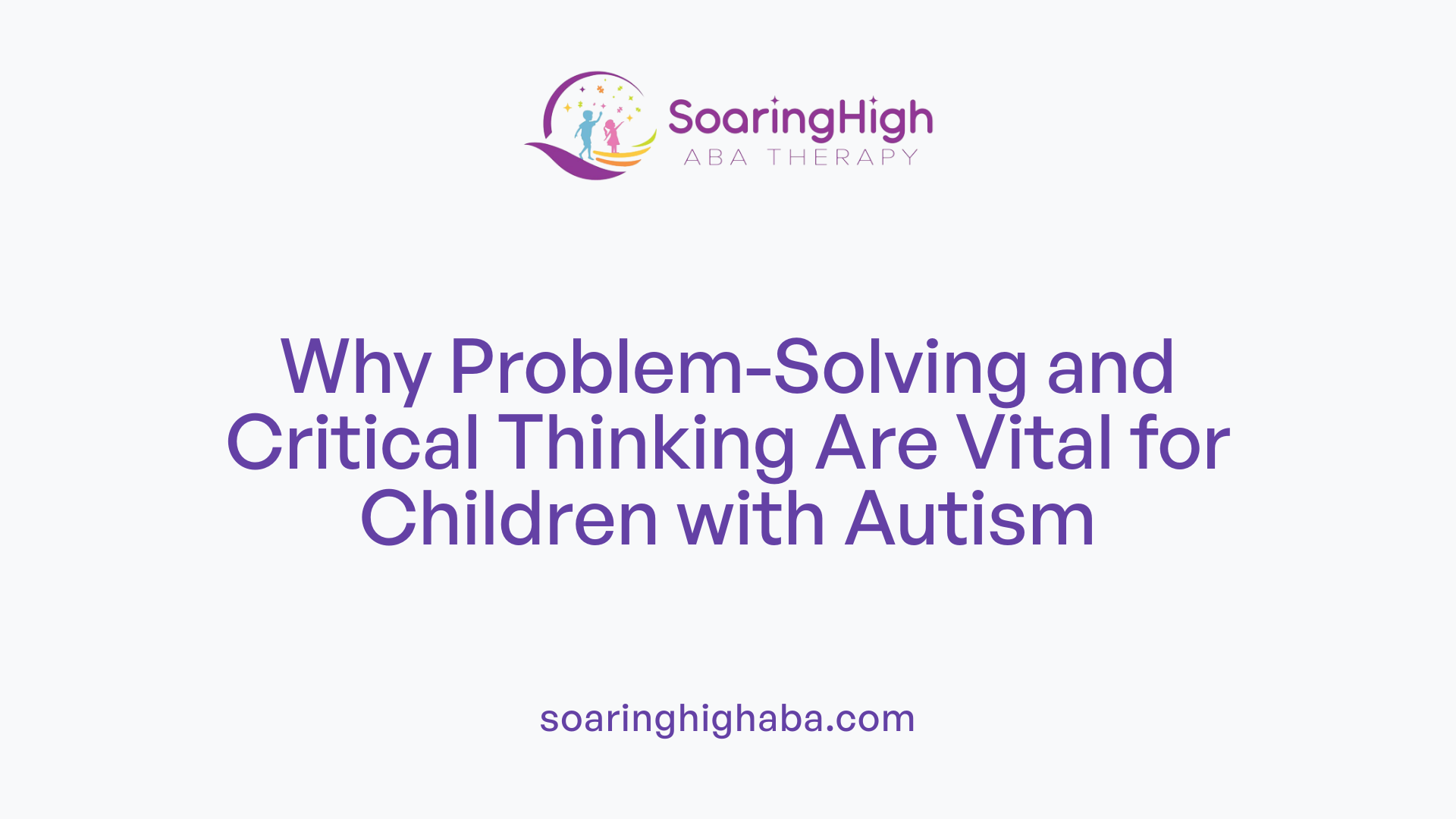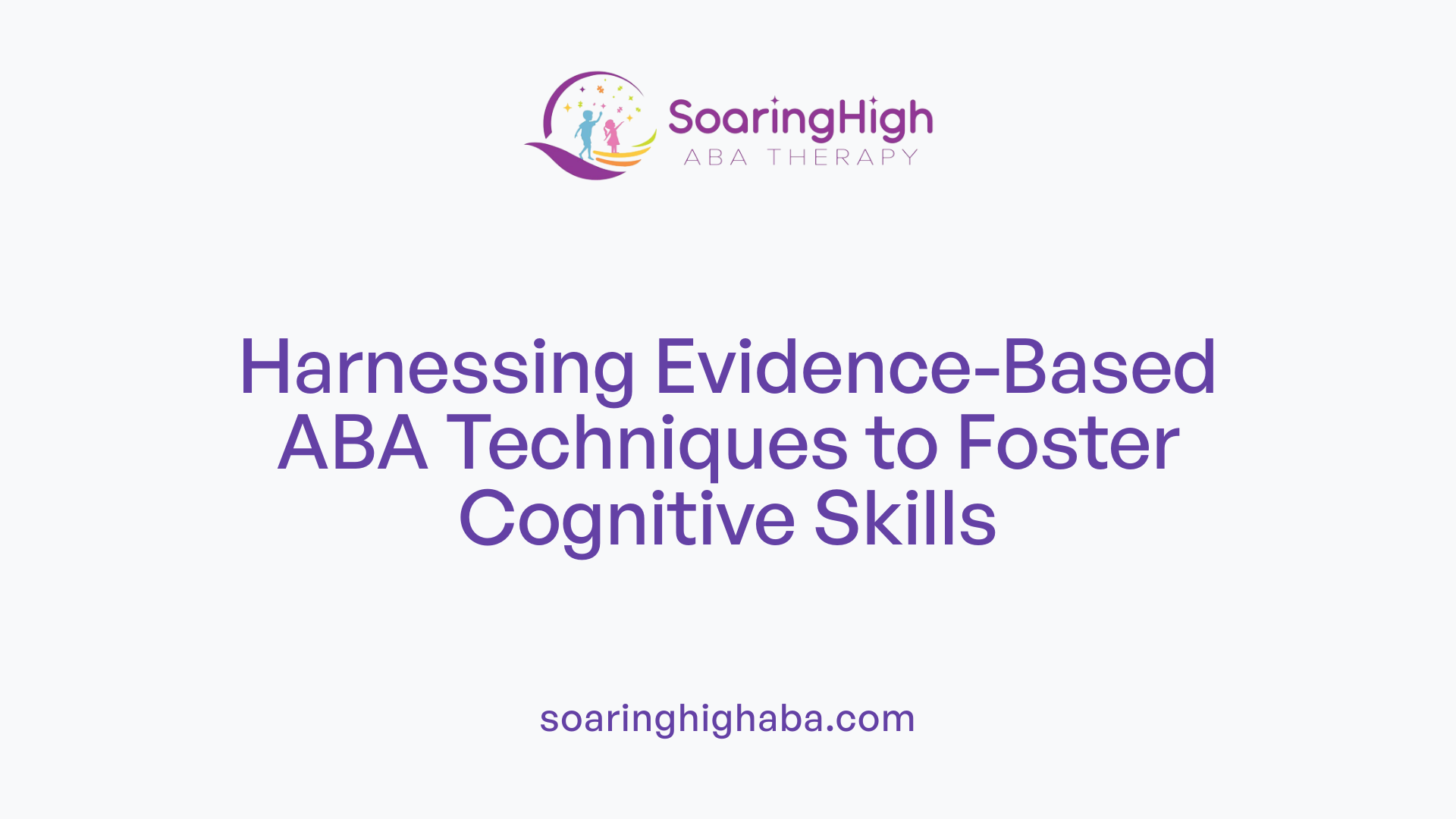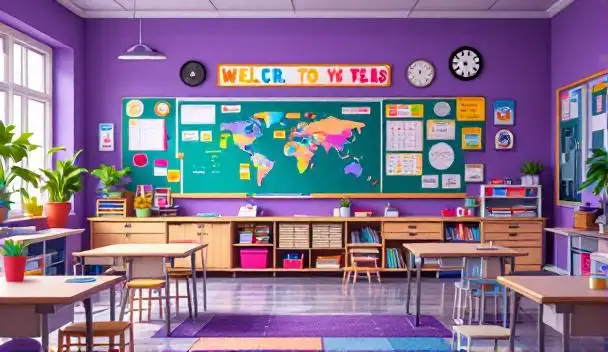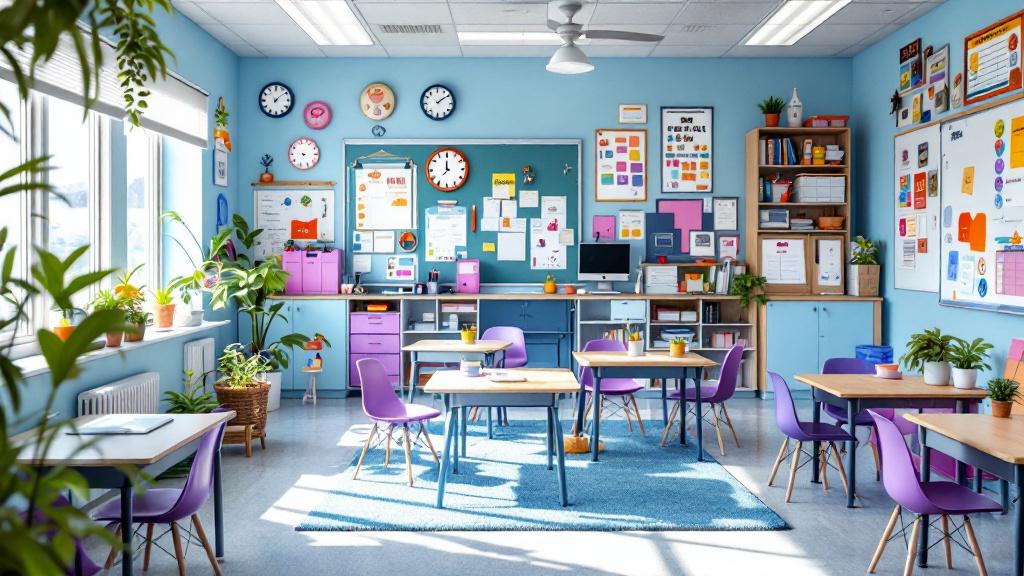A Comprehensive Approach to Developing Problem-Solving and Critical Thinking Skills
Teaching problem-solving and critical thinking skills is fundamental for fostering independence, confidence, and adaptive functioning in children with autism and other neurodivergent profiles. Applied Behavior Analysis (ABA) offers a robust framework that leverages evidence-based strategies to systematically develop these vital cognitive skills. By integrating structured teaching methods, visual supports, and naturalistic activities, educators, therapists, and parents can promote lasting learning and skill generalization across settings. This article explores how ABA strategies are applied in educational and therapeutic contexts to enhance problem-solving and critical thinking, supported by current research and practical techniques.
Understanding the Importance of Problem-Solving and Critical Thinking in Autism

Why are these skills vital for children with autism?
Developing problem-solving and critical thinking skills is essential for children with autism because it directly influences their ability to navigate daily life and succeed academically. These skills help children understand how to approach new challenges, make decisions, and adapt to changing circumstances. By fostering these abilities, children can become more independent and confident, which positively impacts their overall development.
In everyday situations, such as figuring out how to share toys or resolve conflicts with friends, strong problem-solving skills enable children to find effective solutions. Educationally, these skills support learning across subjects, encouraging children to connect concepts, analyze information, and apply their knowledge creatively.
How do these skills help children handle obstacles and make decisions?
Children with autism often face unique obstacles in learning and social interactions. Teaching them to think critically allows them to break down complex problems, consider multiple options, and choose appropriate actions. For example, guiding a child through the steps of stating a problem, brainstorming solutions, selecting the best one, trying it out, and reviewing the outcome fosters a logical approach to challenges.
Furthermore, structured problem-solving supports decision-making by helping children evaluate consequences and develop self-regulation. This process encourages independence and resilience, essential traits for overcoming daily hurdles.
What is the impact on social and emotional development?
Critical thinking and problem-solving skills also contribute significantly to social and emotional growth. When children learn to assess social situations, comprehend different perspectives, and resolve conflicts effectively, they build healthier relationships. This development nurtures empathy, patience, and flexibility.
These skills enable children to handle frustrations better, reduce emotional outbursts, and increase confidence in social settings. Ultimately, fostering these abilities supports a holistic growth that encompasses cognitive, emotional, and social domains.
Resources for teaching problem-solving and critical thinking using ABA strategies
Implementing Applied Behavior Analysis (ABA) techniques is a well-supported method for developing these skills.
Resources for learning ABA strategies include:
| Resource Type | Description | Accessibility |
|---|---|---|
| Online Courses | Provide comprehensive training on ABA principles and techniques | Widely available, often with certification options |
| Workshops & Seminars | Offer hands-on experience with real-life applications | Regional and virtual options |
| Textbooks & Research Journals | Cover theoretical foundations and empirical evidence | Accessible through universities and professional organizations |
| Professional Organizations | Such as BACB, offering guidelines, protocols, and certification | Official websites and resources |
| Downloadable Materials | Includes social stories, protocols, and step-by-step guides | Provided by educational and therapeutic organizations |
| Parent & Teacher Training | Focus on naturalistic teaching methods and case studies | Community programs, online modules |
Engaging in multidisciplinary approaches that include therapy services like speech, occupational, and social skills training enhances the effectiveness of ABA in fostering problem-solving abilities. These resources support educators and caregivers in implementing evidence-based practices tailored to each child's developmental level.
How ABA strategies develop problem-solving and critical thinking in children with autism
Research highlights the effectiveness of ABA techniques in teaching problem-solving skills, notably through methods such as self-questioning, visual imagining, recombining units, and sequencing. These strategies are included in a body of empirical studies involving children and adolescents, focusing on areas like math, spelling, social skills, and communication.
The strategies align with various precurrent repertoires:
| Strategy | Repertoire Type | Application Example |
|---|---|---|
| Behavior Chains | Sequential actions | Completing steps in making a sandwich |
| Rules/Self-Questioning | Cognitive strategies | Asking oneself, “What should I do next?” |
| Visual Imagining | Internal visualization | Mentally rehearsing solving a math problem |
| Recombining Units | Creative problem-solving | Combining learned skills in new contexts |
| Sorting/Sequencing | Organizing information | Arranging story events in order |
While training often emphasizes overt responses, covert problem-solving remains a challenge to measure but is an important future focus. Current research advocates for methods that enhance the efficiency and effectiveness of teaching these skills, especially in complex social and academic scenarios.
Ultimately, teaching children to solve problems and think critically through ABA not only improves their immediate learning but also prepares them for lifelong success. Continued research aims to refine these strategies, making them more accessible and adaptable to diverse needs.
Challenges and future directions
Teaching these skills can be time-consuming and complex, often requiring tailored approaches for individual children. It’s also crucial to monitor maintenance and generalization over time.
Future research priorities include developing methods for teaching covert problem-solving, increasing the efficiency of interventions, and extending these strategies to complex social and academic behaviors. Emphasizing real-time learning and natural environments will enhance outcomes and support the independence of children with autism.
Core Principles and Evidence Supporting ABA for Cognitive Skills Development
 How can ABA strategies be used to teach problem-solving skills?
How can ABA strategies be used to teach problem-solving skills?
Applied Behavior Analysis (ABA) offers a structured approach to teaching problem-solving skills in autistic children. By breaking down complex tasks into smaller, manageable steps, ABA employs techniques like Discrete Trial Teaching (DTT) and task analysis to facilitate learning. These methods involve presenting specific problems or scenarios, providing prompts, and reinforcing correct responses. Role-playing, scenario-based activities, and games simulate real-life decisions, helping children develop practical problem-solving abilities.
Naturalistic and play-based teaching strategies also embed problem-solving opportunities into daily routines. For example, during play, an educator might introduce a task that requires children to choose among options or sequence actions. Reinforcement strategies, such as token economies or differential reinforcement, motivate children to engage actively in solving problems, fostering independence.
Parent collaboration is crucial in reinforcing these skills outside of formal settings. Gradually fading prompts ensures that children transfer learned skills into various environments, increasing their adaptability in everyday life.
How can ABA strategies be applied to develop critical thinking skills?
Developing critical thinking through ABA involves systematic teaching that underscores reasoning and analysis. Visual supports, modeling, prompting, and fading are core techniques that help children understand cause-and-effect and develop logical reasoning. Behavior chaining—a method where sequences of behaviors are linked to achieve a goal—encourages understanding of complex processes.
Reinforcement, both positive and negative, encourages children to practice reasoning and decision-making. Engaging activities such as storytelling, predictive questioning, and exploring different viewpoints stimulate analytical thinking. Over time, children learn to connect concepts, predict outcomes, and evaluate ideas critically.
Creating an environment rich with visual cues and social stories further supports the generalization of critical thinking skills. Consistent routines and expectations help children apply these skills across various settings, improving their ability to analyze situations and approach problems creatively.
What types of repertoires are involved in problem-solving?
Research highlights that successful problem-solving involves multiple classically conditioned behaviors, such as behavior chains, self-questioning, visual imagining, recombining units, and sequencing. Behavior chains allow for a sequence of actions to accomplish a goal, while self-questioning and self-prompting foster internal strategies for reasoning.
Visual imagining helps children mentally simulate solutions before acting, and recombining units or improvising encourages flexible thinking. Sorting and sequencing develop the ability to organize information logically.
Limitations in current research indicate that training often emphasizes overt responses, making it difficult to measure covert problem-solving. Teaching these repertoires requires careful planning and time investment, with ongoing challenges in ensuring generalization across environments.
Future directions include focusing on covert problem-solving and improving training efficiency to handle complex social and academic behaviors. This ongoing research aims to make these methods more accessible and effective.
How do classroom strategies support the development of problem-solving and critical thinking?
Effective classroom strategies include providing structured routines, consistent expectations, and making information accessible through visual supports. Visual schedules, social stories, and task organizers help children understand and anticipate what is expected.
Planning lessons with necessary adaptations and pre-exposing children to new material reduces anxiety and prepares them for learning. Reinforcing desired behaviors using positive reinforcement and creating a safe, supportive environment fosters confidence and encourages participation.
These strategies also involve scaffolding learning by breaking tasks into smaller steps, encouraging active engagement, and prompting children to explore solutions. Facilitating collaborative work and discussion integrates different points of view, enhancing critical thinking.
Teaching problem-solving in real time, especially when children seek help or ask questions, is most effective. It emphasizes being present, listening actively, and guiding children through the process rather than providing immediate solutions.
In summary, combining structured routines, visual supports, and active engagement promotes the development of these vital skills.
| Strategy | Description | Benefits |
|---|---|---|
| Structured routines | Consistent, predictable classroom procedures | Reduces anxiety, enhances learning |
| Visual supports | Visual schedules, prompts, and cues | Clarifies expectations, supports memory |
| Pre-exposure | Introducing material beforehand | Eases transitions, builds confidence |
| Reinforcement | Positive feedback, token economies | Motivates participation |
| Safe space | Quiet areas for processing | Promotes emotional regulation |
| Scaffolding | Breaking down tasks | Facilitates mastery and independence |
| Collaboration | Group problem-solving | Encourages multiple viewpoints |
How can parents supplement classroom strategies at home?
Parents play a vital role in fostering problem-solving and critical thinking skills at home. Asking thought-provoking questions, such as
Techniques for Teaching Problem-Solving via ABA

How can complex problem-solving skills be taught using ABA?
One of the foundational techniques in ABA is breaking down complicated problems into smaller, manageable parts through task analysis. This process enables children to understand each step involved in solving a problem, promoting independence and confidence. For example, a child learning how to share toys may first be guided to recognize the problem, then encouraged to think of possible solutions step-by-step.
Using prompts, such as physical gestures or verbal cues, helps guide the child towards correct responses. Gradually, these prompts are faded out, fostering mastery and encouraging the child to solve similar problems independently. This scaffolding approach ensures the child isn’t overwhelmed and learns how to approach new challenges.
Reinforcement plays a crucial role in solidifying problem-solving behaviors. Continuous reinforcement might be used initially, providing immediate praise or rewards for each successful attempt. Over time, intermittent reinforcement helps maintain skills by rewarding less frequently, mimicking real-life scenarios where constant praise is uncommon.
Incorporating naturalistic and play-based teaching methods allows children to practice these skills in engaging, real-world contexts. For instance, using a game to practice sharing or decision-making helps transfer skills from structured sessions to everyday situations.
Embedding problem-solving within daily routines and involving caregivers enhances generalization. Teaching functional communication skills through methods like Functional Communication Training (FCT) allows children to articulate their problems and needs effectively. Caregivers’ active participation in reinforcement and consistent practice further promotes long-lasting skills.
What methods are employed in ABA to foster critical thinking?
In addition to problem-solving, ABA employs techniques to develop critical thinking skills by encouraging children to analyze information objectively. Data collection and reflection on intervention outcomes help both therapists and children assess progress and adjust strategies.
Teaching observation skills, such as mindfulness and detailed note-taking, enhances a child's ability to evaluate situations accurately. Reflective practices teach children to consider different perspectives and think creatively about solutions.
Structured problem-solving strategies involve teaching children to break down issues, experiment with multiple solutions, and learn from each attempt. This iterative process nurtures adaptive thinking and resilience.
Visual supports like charts, diagrams, and cue cards aid in conceptual understanding and organization of thoughts. Modeling both correct problem-solving behaviors and critical thinking encourages imitation and internalization.
Real-world scenarios and role-play exercises provide safe spaces for practicing these skills, making learning relevant and meaningful. Continuous professional development for educators ensures they stay informed about innovative strategies, fostering a creative and effective learning environment.
How is teaching problem-solving integrated into daily routines?
Embedding problem-solving activities into everyday routines significantly enhances skill transfer. For example, involving children in family decision-making, such as choosing what to eat or what activity to do, offers natural opportunities to practice problem-solving.
Parents and teachers can encourage children to articulate their problems, brainstorm solutions, select the best option, and evaluate the outcome. These steps are simple to incorporate into regular conversations and activities.
Using prompts, reinforcement, and supportive guidance helps children learn these processes smoothly. Asking open-ended questions like “What do you think we should do?” or “Can you tell me a different way to solve this?” promotes critical thinking.
Creating a supportive environment where children feel safe to express ideas and make mistakes boosts confidence. Consistency across settings—home, school, and therapy—ensures that children learn to apply problem-solving skills in various contexts.
How can we foster independence and ensure skills are generalized?
Promoting independence involves gradually reducing adult assistance, allowing children to apply problem-solving strategies on their own.
Caregivers and educators should use natural reinforcement, praise their efforts and successes, and celebrate their ability to manage new challenges.
Generalization is supported by practicing skills across different environments, with diverse problems, and with various people. For example, a child might solve a puzzle at school, then be encouraged to do similar tasks at home.
Providing children with opportunities to reflect on their learning, setting achievable goals, and providing ongoing support fosters autonomous problem-solving. Over time, children develop flexible thinking and adapt skills to broader social and academic situations.
| Technique | Application Example | Benefits |
|---|---|---|
| Task Analysis | Breaking down sharing, cooking, or cleaning tasks | Enhances independence and understanding |
| Prompting and Fading | Verbal or physical cues, gradually removed | Builds confidence and mastery |
| Reinforcement Strategies | Immediate praise, tokens, or preferred items | Motivates and maintains behaviors |
| Naturalistic Teaching | Use of play, routines, or daily activities | Promotes real-life applicability |
| Embedding in Routines | Decision-making during activities like shopping | Encourages ongoing practice |
| Promoting Reflection | Discussing choices and outcomes with the child | Improves critical judgment skills |
By combining these strategies, educators and parents can effectively teach problem-solving and critical thinking skills that children will carry into all aspects of their lives.
Methods to Develop Critical Thinking Skills with ABA

What methods are used in ABA to teach critical thinking skills?
Applied Behavior Analysis (ABA) employs various strategies to nurture critical thinking in children, especially those with autism. Central to these methods is encouraging objective analysis and evaluation of information. Data collection, a cornerstone of ABA, helps both therapists and children reflect on intervention outcomes, fostering analytical thinking.
Teaching observation skills like mindfulness, detailed note-taking, and reflective practice are also crucial. These skills help children become more aware of their thought processes and actions, enabling self-monitoring and better decision-making.
Structured problem-solving strategies are another key component. These involve breaking down complex issues into manageable parts, trying out different solutions, and learning from each experience to adapt future responses.
Incorporating visual supports, such as charts, symbols, and visual schedules, along with modeling and real-world problem-solving scenarios, makes abstract concepts more concrete and applicable.
To stay innovative, practitioners focus on ongoing professional development and keeping up with current research, which supports creative approaches to teaching critical thinking.
Implementing ABA in Educational and Therapeutic Contexts

How are ABA-based strategies applied in educational and therapeutic settings to improve problem-solving skills?
Applied Behavior Analysis (ABA) strategies are extensively used to promote problem-solving and critical thinking skills among children with autism and other developmental challenges. These strategies involve creating structured routines and using visual supports like schedules, charts, and pictures to help children understand and approach problems methodically.
Therapists and educators employ techniques such as discrete trial training and natural environment training to teach specific problem-solving steps. For example, children might be guided through activities that involve identifying a problem, brainstorming possible solutions, choosing the best option, trying it out, and reviewing the outcome.
Reinforcement plays a crucial role; positive feedback encourages children to repeat successful behaviors. Visual supports make abstract concepts more concrete, aiding in the understanding and application of problem-solving steps. Social stories and role-playing scenarios are also used to teach children how to navigate social dilemmas.
Importantly, ABA emphasizes not just teaching skills in isolated settings but also ensuring children can transfer these skills across different contexts. Family involvement is key, with parents trained to reinforce strategies at home, creating a consistent learning environment.
Overall, ABA offers evidence-based, individualized approaches that enhance a child's ability to think critically and solve problems independently, which translates into improved daily functioning and resilience.
What are the challenges and future prospects for teaching problem-solving and critical thinking through ABA?
Teaching complex cognitive skills like problem-solving and critical thinking via ABA presents several hurdles. One primary challenge is the complexity and time-consuming nature of these skills; they often require multiple steps and deeper cognitive engagement, making them harder to teach and master.
Furthermore, most current ABA training emphasizes overt responses, while covert problem-solving—things happening inside the child's mind—is difficult to measure and observe. This limits understanding of the internal processes involved in problem solving.
Another challenge lies in ensuring skills are maintained over time and generalized across settings. Research indicates that without ongoing reinforcement, many acquired skills may diminish, and children may struggle to apply learned strategies in real-world situations.
Looking ahead, future research should focus on increasing the efficiency of teaching methods, identifying ways to support covert problem-solving, and improving the transfer of skills to different environments. Enhancing technology use, such as digital simulations and interactive apps, can also augment traditional ABA approaches.
Despite these obstacles, ABA's evidence-based framework remains promising. Continuous innovation, cross-disciplinary collaborations, and integrating new technologies hold potential for advancing how critical cognitive skills are taught and sustained in children with autism.
Conclusion: The Promise of ABA in Cognitive Skill Development
What are the most effective strategies and applications for teaching critical thinking and problem-solving skills?
Teaching critical thinking and problem-solving skills to children, including those with autism, involves using structured, evidence-based methods. Applied Behavior Analysis (ABA) is a prominent approach that emphasizes gradual skill-building through structured learning routines. Key strategies include providing clear visual supports, creating predictable routines, and teaching problem-solving steps such as identifying the problem, brainstorming solutions, and evaluating outcomes.
In classrooms, teachers can implement these strategies by planning lessons that introduce new concepts in advance, reinforcing desired behaviors, and maintaining a safe, supportive environment. At home, parents serve as vital partners by asking open-ended questions, encouraging different problem-solving approaches, and modeling logical reasoning.
Research shows that specific ABA techniques—like self-questioning, visual imagining, and sequencing—are effective for developing problem-solving skills across areas including math, social interactions, and communication. These methods often involve training children to complete behavior chains and utilize rules or prompts to facilitate covert and overt problem-solving.
Why is a tailored, comprehensive approach essential?
Children with autism and other neurodivergent learners benefit most from personalized interventions that combine behavioral strategies with creative, engaging methods. The complexity of teaching problem-solving means strategies must be adaptable to each child's developmental level and interests. Tailoring strategies ensures the reinforcement of transferable skills that children can apply across various contexts.
Incorporating creativity and individual preferences helps sustain motivation and enhances learning. For example, using visual storytelling, role-playing, and interactive activities can make problem-solving more meaningful and accessible.
How important is collaboration among educators, parents, and therapists?
Effective development of critical thinking and problem-solving skills relies heavily on collaboration among teachers, parents, therapists, and other stakeholders. Regular communication ensures consistency and reinforces learning across different settings. Teachers can share strategies with parents for use at home, and therapists can tailor interventions based on classroom experiences.
Joint efforts can involve co-creating visual supports, co-teaching problem-solving tasks, and engaging in family problem-solving meetings. This holistic approach ensures that children receive coherent, sustained support that promotes skill generalization and everyday application.
What are the prospects for ongoing learning and future research?
Continued research seeks to improve teaching methods, making them more efficient and adaptable for complex social, emotional, and academic learning. Future directions include developing techniques to teach covert problem-solving, increasing the speed of skill acquisition, and facilitating skills transfer to real-world situations.
Emerging technology, such as digital tools and virtual reality, offers promising avenues for enhancing engagement and feedback. Additionally, expanding research on long-term maintenance and generalization will help ensure these skills are sustainable and functional in daily life.
Resources for Learning ABA Strategies to Enhance Problem-Solving and Critical Thinking Skills
To deepen understanding and practical application, several trusted resources are available. These include online courses, workshops, and comprehensive textbooks focused on evidence-based ABA practices.
Professional organizations, such as the Behavior Analysis Certification Board (BACB), provide certifications, guidelines, and access to recent research articles. Many websites offer downloadable materials, including social stories, teaching protocols, and step-by-step guides suited for different developmental levels.
Parent and teacher training programs often emphasize real-time teaching methods and naturalistic learning environments. Multidisciplinary approaches, incorporating speech, occupational, and social therapy, further enhance the development of cognitive and social skills through ABA techniques.
Table of ABA Resources for Cognitive Development in Children with Autism
| Resource Type | Description | Access/Examples |
|---|---|---|
| Online Courses | Structured training on ABA methods | Centers like the BACB, autism-specific training platforms |
| Workshops | Practical, hands-on training sessions | Local and national conferences, webinars |
| Textbooks & Guides | Evidence-based instructional materials | Publications such as |
Final Thoughts and Future Directions in ABA-Based Cognitive Skills Education
Incorporating ABA strategies into educational and therapeutic practices offers a systematic, individualized, and effective means of teaching problem-solving and critical thinking skills. When structured around evidence-based methods like task analysis, reinforcement, and naturalistic teaching, ABA enables learners with autism to develop crucial cognitive competencies that translate into greater independence and success across life domains. Ongoing research, resource sharing, and interdisciplinary collaboration are vital for overcoming current limitations and advancing best practices. As the field continues to evolve, embracing innovation and personalized approaches will ensure meaningful progress, empowering children to navigate their worlds more confidently and creatively.
References
- Teaching Autistic Children Critical Thinking Skills
- Critical Thinking Skills, Problem Solving, and Academic and ...
- Empirical Evaluations of Skinner's Analysis of Problem ...
- 7 Ways to Teach Critical Thinking in Elementary Education
- Problem Solving | How to Teach Young Children
- Understanding the Pros and Cons of ABA Therapy
- 10 Ways ABA Therapy Can Help with Life Skills
- How ABA Therapy Can Help Children with Autism Thrive
- Using ABA Therapy in School Settings
- Functional Communication Training: Teaching Asking for a ...





































































































